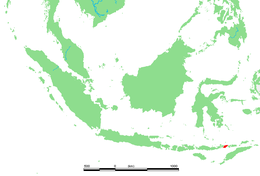Lembata
Native name: Pulau Lembata | |
|---|---|
 Location in Indonesia | |
| Geography | |
| Location | Lesser Sunda Islands |
| Coordinates | 8°24′S 123°34′E / 8.40°S 123.57°E |
| Area | 1,266.39 km2 (488.96 sq mi) |
| Highest elevation | 1,533 m (5030 ft) |
| Administration | |
| Province | East Nusa Tenggara |
| Regency | Lembata Regency |
| Largest settlement | Lewoleba (pop. 40,200) |
| Demographics | |
| Population | 135,930 (2020 Census) |
| Pop. density | 107.34/km2 (278.01/sq mi) |
Lembata is an island in the
To the west lie the other islands in the archipelago, most notably Solor and Adonara, and then the larger island of Flores. To the east is the Alor Strait, which separates this archipelago from the Alor Archipelago. To the south across the Savu Sea lies the island of Timor, while to the north the western branch of the Banda Sea separates it from Buton and the other islands of Southeast Sulawesi.
Administration
The Lembata Regency includes the island of Lembata and three small offshore islands. It is sub-divided into nine districts.
Geography

The capital city Lewoleba (also known as Labala) is found on the western part of the island next to a bay, across which lies Lewotolo volcano to the north.[1] Ships frequently connect the coastal towns and surrounding islands, but the only bigger harbour exists at Lewoleba in the north of the island. From Lewoleba there are daily connections to Larantuka, Flores, and Waiwerang on the neighbouring island of Adonara.
Like the other Lesser Sunda Islands, and indeed much of Indonesia, Lembata is volcanically active. It has three volcanoes,
History
The south part of Lembata was the site of the state of Labala.
People
The people of Lembata are, like many other inhabitants of Eastern Indonesia, famous for their handmade ikat weavings.
The national language,
On the south coast of Lembata, the village of Lamalera (pop. 2,500) is known for its
Environment
In 2011, the
The two species were the first to be found in Lamalera Sea, but similar types have been found near Bali before. The fish were only found in seas with good coral reefs, although traces of bombing had been found around the coral reefs in the Lamalera Sea, but it was not serious yet.[6]
In February 2016, a new species of flasher wrasse, Paracheilinus alfiani, was described from a holotype collected from the reef around Lembata.[7]
References
- ^ "Global Volcanism Program | Lewotolok". Smithsonian Institution | Global Volcanism Program. Retrieved 2022-09-14.
- ^ Krauße, Daniel (2016). "A Brief Grammar of the Eastern Atadei Language of Lembata, Indonesia" (PDF). Linguistik Indonesia. 34 (2): 115–116. Retrieved 9 August 2017.
- ISBN 3875480163.
- ^ Emont, Jon (3 August 2017). "A Whaling Way of Life Under Threat". The New York Times. Retrieved 24 May 2022.
- ^ "Spearing Whales For Survival: An Inside Look". Underwater360. 7 August 2018. Retrieved 24 May 2022.
- ^ "Two rare fishes found in East Nusa Tenggara". November 24, 2011.
- ^ Adams, Jake. ""Paracheilinus alfiani, P. paineorum & P. xanthocirritus, three new flasher wrasses"". 30 August 2017.
